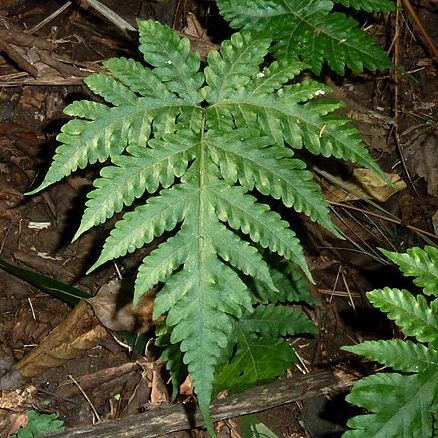Plants terrestrial. Rhizome erect to suberect, to 100 mm long, to 12 mm in diameter, set with roots, crowded persistent stipe bases and scales, scales chartaceous, concolorous or bicolorous, if bicolorous then centrally castaneous with paler margins, adnate, lanceolate, margins closely set with unicellular, bicellular, and simple and branched hairs along the margin, also with unicellular hairs on the scale surface, to 15 mm long, to 5 mm wide. Fronds crowded, caespitose, arching, to 1.6 m long; stipe firm, proximally castaneous, stramineous higher up, adaxially sulcate, to 750 mm long, to 9 mm in diameter, initially densely scaled at the base, sparsely scaled higher up, scales similar to those on the rhizome; lamina catadromous, ovate-deltate, 2-pinnate-pinnatifid, to 850 mm long, to 900 mm wide, with up to 4 petiolated pinna pairs, pinnatifid towards the apex; rachis stramineous, adaxially sulcate, sulcus not open to that of the lower order axes, closely set with pluricellular, acicular hairs, to 0.25 mm long, winged for most of the length, often with several proliferous buds dorsally near the apex; pinnae opposite to alternate, proximal pinna pair basiscopically developed, 1-pinnate-pinnatifid, inequilaterally ovate to oblong-cuneate, to 520 mm long, to 340 mm wide, generally with a single sessile or short-stalked pinnule pair, pinnatifid towards the apex, usually slightly overlapping; pinna-rachis convex adaxially, densely set with stramineous acicular hairs to 250 mm long, sparsely haired abaxially, often with several proliferous buds dorsally near the apex; pinnules sessile or petiole to 2 mm long, opposite to alternate, herbaceous, narrowly lanceolate to oblong-cuneate, acroscopic pinnule on the basal pinna to 138 mm long, to 40 mm wide, basal pinnule on the basal pinna to 295 mm long, to 90 mm wide, pinnatifid to lobed, shallowly repand, adaxially sparsely set with pluricellular acicular and 3-celled clavate hairs along the veins, abaxially sparsely set with 2-celled acicular hairs along the veins and 2-celled clavate hairs between the veins. Venation anadromous and catadromous, basiscopic primary vein in the upper pinnae/pinnules usually arises from the rachis or secondary rachis, reticulate, areolae usually without included free veinlets, the free vein branches end in the costae near the margin in slightly enlarged endings. Sori circular, to 1.5 mm in diameter, on a vein, at a vein plexus, or on a simple or branched included free veinlet, in a single row on either side of the costule; sporangium long-stalked, 3-seriate below the capsule, with 2 or 3 usually 3-celled hairs below the sporangium, capsule globose in lateral view, with (12-)13(-14) indurated annulus cells, epistomium (3-)4-celled, hypostomium (3-)4-celled; indusium pale brown, firmly herbaceous, circular, reniform, variously set with oblong 1-5-celled hairs along the margin and surface, to 1.2 mm in diameter; receptacle nude. Spores 64 per sporangium, stramineous, subellipsoidal, monolete, perispore forming broad wings, cristate, to (30-)34.8(-40) x (22-)26.3 (-32) µm.
More
Rhizome erect, up to 20 mm in diameter, set with very dark brown rhizome-scales up to 8 mm long with paler borders. Fronds arching, herbaceous, with proliferating bulbils up to 10 mm in diameter on costae and costules; stipe matt brown, up to 0.75 m long, thinly pubescent with minute white hairs and set with scales basally; lamina ovate-deltate-acute, up to 0.9 x 0.6 m, 3-pinnatifid, basal pinnae greatly developed basiscopically, unequally deltate; upper pinnae deeply pinnatifid into narrowly oblong, somewhat falcate, crenate, pubescent lobes; veins usually anastomosing, without included veinlets; rhachis with decurrent lamina wings near apex and pubescent with minute pale brown hairs. Sori up to 2 mm in diameter; indusium membranous, minutely ciliate, c. 1 mm in diameter.
Rhizome erect, up to 20 mm in diameter, set with dark brown rhizome scales. Veins anastomosing. Fronds arching, with proliferating bulbils up to 10 mm in diameter on costae and costules. Lamina ovate-triangular, up to 0.9 x 0.6 m, 3-pinnatifid, pubescent on both surfaces. Indusium membranous.
A fern. It grows 30-100 cm tall. It has an erect rhizome 2 cm across. This has dark brown scales with lighter edges. The fronds are in tufts and arch over. They are 1.8 m long. The fronds near small plantlets.

